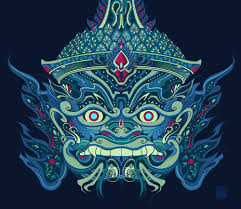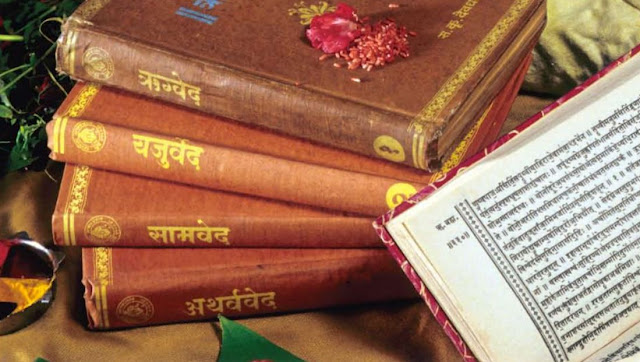Yaksha, who is considered probably the oldest commentator of the Vedas, gives the following classification of the Vedic Gods and Gddesses. Basically there are three deities, according to the expounders of the Vedas: “Agni”, (the fire god) whose place is on the earth; Vāyu or Indra, (the air and thunder storm god) whose place is in the air; and Surya, (the sun god) whose place is in the sky. These deities receive severally many appellations in consequence of their greatness, or of the diversity of their functions. According to the Rig-Veda, the number itself counts to thirty-three. Amongst these thirty-three, eleven are said to be in heaven, eleven on earth, and eleven in mid-air. Agni, being the wise God, lends an ear to his worshippers. God with the ruddy steeds, who lovest praise, bring hither those three-and-thirty." This is the number usually mentioned, though it is by no means easy to decide which are intended to be thirty-three, as the lists found, considerably varies in various places where ever it is documented; however in another verse it is said that three hundred, three thousand, thirty-and-nine gods have worshiped Agni.
As describes in the Vedas, the deities, though spoken of as immortal, are not said to be self-existent beings; in fact their parentage in most of the cases is given; however on various accounts of their origin do not agree with each other. Agni and Savitri are said to have conferred immortality upon the other gods; where as it is also preached that Indra obtained this boon by sacrifice. An interesting account is given in the Satapatha Brāhmana of the means by which the gods obtained immortality, and superiority over the asuras or demons. All of them, gods and demons alike, were mortal, all were equal in power, all were sons of Prajāpati the Creator. Wishing to be immortal, the gods offered sacrifices liberally, and practised the severest penance; but not until Prajāpati had taught them to offer a particular sacrifice could they become immortal. They followed his advice, and succeeded. Wishing to become greater than the asuras (the demons), they became truthful. Previously they and the asuras spoke truthfully or falsely, as they thought fit; but gradually, whilst they ceased from lying, the asuras (the demons) became increasingly false; the result was that the gods after protracted struggles gained the victory. Originally the gods were all equal in power, all alike good. But three of them desired to be superior to the rest, viz. Agni, Indra, and Surya. They continued to offer sacrifices for this purpose until it was accomplished. Originally there was not in Agni the same flame as there is now. While offering the sacrifice, the offerer of the sacrifice used to desire, "May this flame be in me," and, offering a sacrifice for the attainment of this blessing, obtained it. In the similar manner Indra increased his energy, and Surya increased his brightness. These three deities form what is commonly described as in the Vedic Triad. In later period of time other three took their place, though an attempt is made to show them to be the same.
Later you will notice that each of the gods is in turn regarded by the worshipper as superior to all of the others. In the Vedas this superlative language is constantly employed, and identical epithets are indiscriminately given to various deities.When these individual gods were invoked, they were not conceived as limited by the power of others, as superior or inferior in rank. Each god, to the mind of the supplicants, is as good as all the gods. He is felt at the time as a real divinity, as supreme and absolute, in spite of the limitations which, to our mind, a plurality of gods must entail on every single god. All the rest disappear for a moment from the vision of the poet, and he only who is to fulfil their desires, stands in full light before the eyes of the worshippers. . . . It is easy to find, in the numerous hymns of the Rig-Veda, passages in which almost every single god is represented as supreme and absolute".
Later you will notice that each of the gods is in turn regarded by the worshipper as superior to all of the others. In the Vedas this superlative language is constantly employed, and identical epithets are indiscriminately given to various deities.When these individual gods were invoked, they were not conceived as limited by the power of others, as superior or inferior in rank. Each god, to the mind of the supplicants, is as good as all the gods. He is felt at the time as a real divinity, as supreme and absolute, in spite of the limitations which, to our mind, a plurality of gods must entail on every single god. All the rest disappear for a moment from the vision of the poet, and he only who is to fulfil their desires, stands in full light before the eyes of the worshippers. . . . It is easy to find, in the numerous hymns of the Rig-Veda, passages in which almost every single god is represented as supreme and absolute".
The will of these gods is sovereign; no mortal can thwart their designs. They exercise authority and power over all creatures. In their hands is the life of mortals. They know the thoughts and intentions of men, and whilst they reward the worshipper, they punish those who neglect them.
When the descriptions of Puranic deities comes you will notice that the representations of the deities of that age are far more clearly defined than those of the earlier times. Though the Vedic gods are spoken of as possessing human forms and acted like human beings, there is considerable vagueness in the outline. However as time goes on this is lost. The objects of worship are no longer indistinct and shadowy, but are so minutely described that their portraits could be easily painted. And as their physical features are no longer left to the imagination form, so their mental and moral characters are fully delineated. They are of like passions with those who depict them, only possessing vastly greater power,
The deified forces addressed in the Vedic hymns were probably not represented by images or idols in the Vedic period, though undoubtedly the early worshippers clothed their gods with human forms in their own imaginations.
The religion of the Veda knows of no idols. The worship of idols in India is a secondary formation, a later degradation of the more primitive worship of ideal gods.From the common appellation of the gods as divo naras, “men of the sky”, or simply naras, “men”, and from the epithet nripesas, “having the form of men”, we may conclude that the Indians did not just merely in imagination assign human forms to their gods, but also represented them in a sensible manner. Thus a painted image of Rudra (Rig-Veda, ii. 33, 9) is described with strong limbs, many-formed, awful, brown, he is painted with shining colours.
Still clearer appears the reference to representations in the form of an image. “I now pray to the gods of these (Maruts)…………”.Here it seems that the Maruts are distinguished from their gods, i.e. their images.There is in the oldest language a word, Sandris, which properly denotes an image of the gods.
The deified forces addressed in the Vedic hymns were probably not represented by images or idols in the Vedic period, though undoubtedly the early worshippers clothed their gods with human forms in their own imaginations.
The religion of the Veda did not use idols for their purpose religious rituals and worship purpose. The worship of idols in India is a secondary formation, in the later degradation of the more primitive worship of ideal gods.From the common appellation of the gods as divo naras, “men of the sky”, or simply naras, “men”, and from the epithet nripesas, “having the form of men”, we may conclude that the Indians did not just merely in imagination assign human forms to their gods, but also represented them in a sensible manner. Thus a painted image of Rudra (Rig-Veda, ii. 33, 9) is described with strong limbs, many-formed, awful, brown, he is painted with shining colours.Still clearer appears the reference to representations in the form of an image. “I now pray to the gods of these (Maruts)…………”.Here it seems that the Maruts are distinguished from their gods, i.e. their images.There is in the oldest language a word, Sandris, which properly denotes an image of the gods.
Image Courtesy: Internet
When the descriptions of Puranic deities comes you will notice that the representations of the deities of that age are far more clearly defined than those of the earlier times. Though the Vedic gods are spoken of as possessing human forms and acted like human beings, there is considerable vagueness in the outline. However as time goes on this is lost. The objects of worship are no longer indistinct and shadowy, but are so minutely described that their portraits could be easily painted. And as their physical features are no longer left to the imagination form, so their mental and moral characters are fully delineated. They are of like passions with those who depict them, only possessing vastly greater power,
The deified forces addressed in the Vedic hymns were probably not represented by images or idols in the Vedic period, though undoubtedly the early worshippers clothed their gods with human forms in their own imaginations.
The religion of the Veda knows of no idols. The worship of idols in India is a secondary formation, a later degradation of the more primitive worship of ideal gods.From the common appellation of the gods as divo naras, “men of the sky”, or simply naras, “men”, and from the epithet nripesas, “having the form of men”, we may conclude that the Indians did not just merely in imagination assign human forms to their gods, but also represented them in a sensible manner. Thus a painted image of Rudra (Rig-Veda, ii. 33, 9) is described with strong limbs, many-formed, awful, brown, he is painted with shining colours.
Still clearer appears the reference to representations in the form of an image. “I now pray to the gods of these (Maruts)…………”.Here it seems that the Maruts are distinguished from their gods, i.e. their images.There is in the oldest language a word, Sandris, which properly denotes an image of the gods.
The deified forces addressed in the Vedic hymns were probably not represented by images or idols in the Vedic period, though undoubtedly the early worshippers clothed their gods with human forms in their own imaginations.
The religion of the Veda did not use idols for their purpose religious rituals and worship purpose. The worship of idols in India is a secondary formation, in the later degradation of the more primitive worship of ideal gods.From the common appellation of the gods as divo naras, “men of the sky”, or simply naras, “men”, and from the epithet nripesas, “having the form of men”, we may conclude that the Indians did not just merely in imagination assign human forms to their gods, but also represented them in a sensible manner. Thus a painted image of Rudra (Rig-Veda, ii. 33, 9) is described with strong limbs, many-formed, awful, brown, he is painted with shining colours.Still clearer appears the reference to representations in the form of an image. “I now pray to the gods of these (Maruts)…………”.Here it seems that the Maruts are distinguished from their gods, i.e. their images.There is in the oldest language a word, Sandris, which properly denotes an image of the gods.
Image Courtesy: Internet





Comments
Post a Comment